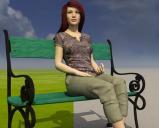TA tints everything in the color of the ground plane
 Electro-Elvis
Posts: 896
Electro-Elvis
Posts: 896
I have a question regarding TA.
I have made a test render to demonstrate my problem. I have zoomed it a bit. I have use premium effects with TA with 36 rpp and a maximum ray depth of 4. On the left side a green plane is used on the right side a grey.

In my opinion TA is not quite physically correct. For example when the green plane is used the lady's neck is too greenish, though it is actually covered by her torso. But TA does not seem to consinder objects between the starting points of the emitted TA rays and the target. And it also does not consinder the distance between the starting point and the target either. Is there a solution for that, except to use gray planes ;-) Thanks in advance for any hint.


g2_ta_problem.jpg
876 x 705 - 161K


Comments
I think that at the moment there is no solution to this problem. For example, the blue sky colors all the objects in the scene in blue.
Elvis,
Welcome to the truth about True Ambience. You are right, TA by default is not the least bit physically accurate, as I've stated many many times. That is why you MUST enable Boost Light and you must also enable Scattering Correction to remove the types of biases you are noticing. Make sure that Focused Scattering is also disabled, because if both methods are active at once the engine will default to focused scattering. Test render the file again with the porper settings and compare the differences.
I've explained this many times but for the sake if clarity I'll describe again why TA is only accurate when Boost Light and Scattering Correction are both enabled.
1. Scattering Correction- Old TA used a Focused Scattering of rays which caused the TA light to concentrate along certain angles and to be underpowered along other angles. That is probably why her arm gets too much green from the ground. The Focused scattering seems to prefer right angles, and the ground plane thus becomes a bit of a laser beam because all of it's polygons face upward. If Scattering Correction had been enabled, the green on the underside of her arm would not be so concentrated and would appear to spread more evenly.
2. Boost Light- Old TA used to place an arbitrary clip onto the values of the pixel brightness and color saturation. Exactly how this ewas done isnt omporatn, but the end effect was as if some degree of gray was mixed in to everything. It had several side effects, such as creating flat looking renders. But the important thing to keep in mind is that it limited the amount of potential variance between adjacent pixels, creating a smoother looking surface with fewer samples. The purpose of this was to reduce noise in the final render output and thus to save dramatically on rendering time. Cool trick, and only those who were extremely well trained visually would have seen the difference back then. However, as soon as High dynamic range light sources became available in Bryce, the arbitrary clipping of TA meant that it could not reflect the colors of the hdri as it should have. That sucked. This forced the programmers during Bryce 7 development to look much more carefully at the code for TA and they discovered this "cap" of sorts. So they created a new GI algorithm called Boost Light that would remove said cap, allowing the pixel to display only the information it gathered, rather than averaging that gathered input with some other arbitratiy value for the simple purpose of lowering noise. The name Boost Light is problematic, because it implies that there is something extra being added, but no, it is merely a correction to the otherwise biased rendering of TA under normal circumstances. Boost Light gives you a much more accurate sampling of the environemnt by not watering down any of the gathered inputs. Adjacent pixels are allowed to differ from one another as much as they want. It also means that you will need higher rpp settings to get rid of the noise, because unless you fire the necessary number of rays to gather the room accurately, you will have dark pixels. This is why we asked for higher maximum rpp settings, because 256 isnt very much for an unbiased engine to reach convergence. Just look at the samples per pixel for Octane. I usually go to 3000 to 16000 rpp to get a clean image. No wonder Boost Light still looks so noisy at maximum 256. The problem isnt boost light, the problem is the slowness of the Bryce Render engine and their fear of enabling higher levels of rpp because of it. Let's hope for Bryce 8 they'll both speed up rendering and also allow rpp into the thousands when necessary.
TA is something of a lie. Ironic.
TA alone= No physical accuracy. Fully "Doctored" Results
TA +Boost LIght + Scattering Correction= Nearly Unbiased Rendering / as close to physically accurate as Bryce is currently capable of.
Hello Rashad
Thank you very much for your detailed explanation. When I read your text I remembered, I have read your statements about the preferences of the old TA to send the rays along a certain angle earlier. But I am sorry I could not made the right connection between your information and my problem. Again thanks a lot. The drawback as you mentioned is really the additional noise.